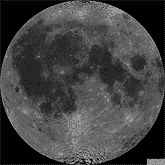Lunar Explorations
 Ever since the beginning of intelligent life on Earth, the moon has been a focal point of human curiosity. Galileo’s discovery in 1610 that the moon had craters, valleys and mountains, instead of the smooth surface previously believed, only added to a burning desire to learn more.
Ever since the beginning of intelligent life on Earth, the moon has been a focal point of human curiosity. Galileo’s discovery in 1610 that the moon had craters, valleys and mountains, instead of the smooth surface previously believed, only added to a burning desire to learn more.
So when exactly did our up-close-and-personal explorations begin? It was in 1959 that the Russians started sending their Luna probes to the moon. The first man-made object to land (actually, crash) on the moon was Luna-2. That same year Luna-3 sent the first images of the far side of the moon – the side hidden from the Earth for more than 4.5 billion years. The USA caught up with the Russians in 1969 when the first manned mission, Apollo 11, landed on July 20. 'That's one small step for man, one giant leap for mankind,' Neil Armstrong proclaimed as he stepped onto the lunar surface. (He was supposed to say 'one small step for a man,' but he misspoke under the pressure of that historical moment.) Since that day, five more manned Apollo missions have landed on the moon. The last one, Apollo 17, left the moon on December 14, 1972, and no humans have returned since. All together only ten humans, none of them women, have walked on the surface of the moon.
About the Author
Anton Skorucak, MS
 Anton Skorucak is a founder and publisher of ScienceIQ.com. Anton Skorucak has a Master of Science (MS) degree in physics from the University of Southern California, Los Angeles, California and a B.Sc. in physics with a minor in material science from the McMaster University, Canada. He is the president and creator of PhysLink.com, a comprehensive physics and astronomy online education, research and reference web site.
Anton Skorucak is a founder and publisher of ScienceIQ.com. Anton Skorucak has a Master of Science (MS) degree in physics from the University of Southern California, Los Angeles, California and a B.Sc. in physics with a minor in material science from the McMaster University, Canada. He is the president and creator of PhysLink.com, a comprehensive physics and astronomy online education, research and reference web site.


